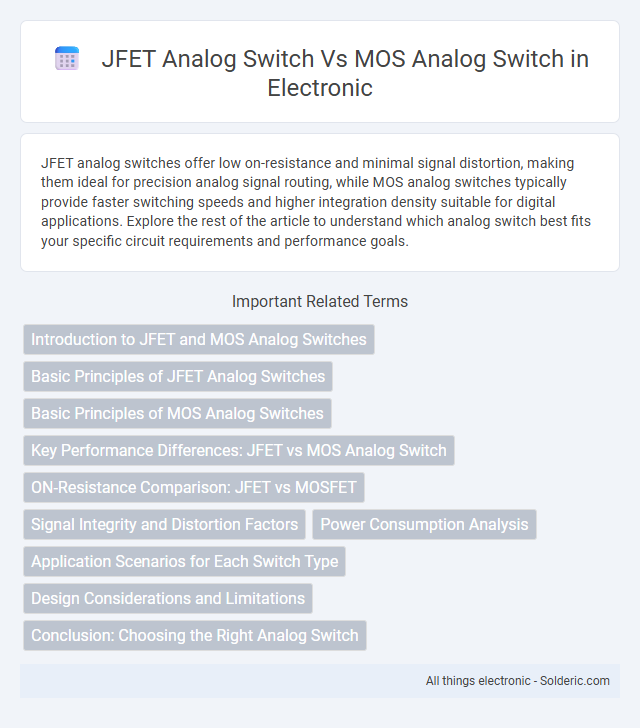JFET analog switches offer low on-resistance and minimal signal distortion, making them ideal for precision analog signal routing, while MOS analog switches typically provide faster switching speeds and higher integration density suitable for digital applications. Explore the rest of the article to understand which analog switch best fits your specific circuit requirements and performance goals.
Comparison Table
| Feature | JFET Analog Switch | MOS Analog Switch |
|---|---|---|
| Technology | Junction Field Effect Transistor (JFET) | Metal-Oxide-Semiconductor Field Effect Transistor (MOSFET) |
| Voltage Range | Typically +-15V | Wide range, often up to +-20V or more |
| On-Resistance (RON) | Lower, typically 5-20O | Varies, typically 10-100O |
| Linearity | Excellent, low distortion | Good, but may have higher distortion at higher frequencies |
| Leakage Current | Higher leakage current | Lower leakage current |
| Switching Speed | Slower switching speed | Faster switching speed |
| Control Voltage | Requires negative control voltage relative to source | Single supply or CMOS compatible control voltage |
| Power Consumption | Higher quiescent power consumption | Lower quiescent power consumption |
| Applications | Audio signal switching, precision analog applications | General-purpose switching, multiplexers, data acquisition |
Introduction to JFET and MOS Analog Switches
JFET analog switches use junction field-effect transistors to control signal flow with low on-resistance and minimal distortion, making them ideal for high-precision analog applications. MOS analog switches, based on metal-oxide-semiconductor transistors, offer fast switching speeds and low power consumption, suitable for digital and analog signal routing. Your choice depends on the required signal integrity, speed, and power efficiency for the specific application.
Basic Principles of JFET Analog Switches
JFET analog switches operate by controlling the current flow through a channel using the voltage applied to the gate terminal, which modulates the channel conductivity without a physical gate current, resulting in low power consumption and low on-resistance. These switches exhibit high input impedance and minimal leakage current, making them ideal for precision analog signal switching. Your application benefits from JFET switches' linear response and low distortion, especially in audio and sensor signal processing circuits.
Basic Principles of MOS Analog Switches
MOS analog switches operate based on the voltage-controlled conductivity of MOSFET channels, allowing signal paths to be opened or closed with minimal resistance. These switches use complementary MOS transistors to achieve low on-resistance and high off-isolation, making them suitable for precision analog signal routing. Your circuit benefits from their efficient control, low leakage current, and excellent linearity when handling analog signals.
Key Performance Differences: JFET vs MOS Analog Switch
JFET analog switches offer low on-resistance and excellent linearity, making them ideal for high-precision analog signal applications with minimal distortion. MOS analog switches typically feature faster switching speeds and lower power consumption but may exhibit higher on-resistance and increased charge injection compared to JFETs. Your choice depends on whether superior analog signal integrity (favoring JFET) or faster, low-power operation (favoring MOS) is more critical for your design.
ON-Resistance Comparison: JFET vs MOSFET
JFET analog switches typically exhibit a higher ON-resistance (R_DS(on)) than MOSFET analog switches, impacting signal integrity and power efficiency in precision circuits. MOSFET switches benefit from lower ON-resistance due to their channel structure and gate control, making them more suitable for applications requiring minimal voltage drop and power loss. Your choice between JFET and MOS analog switches should consider the ON-resistance impact on overall circuit performance and signal fidelity.
Signal Integrity and Distortion Factors
JFET analog switches exhibit superior signal integrity due to their low on-resistance and minimal junction capacitance, which reduces signal distortion and preserves waveform fidelity. MOS analog switches, while offering faster switching speeds, often introduce higher charge injection and nonlinear capacitance effects that can degrade analog signal quality. Understanding these distortion factors helps you select the appropriate switch type for high-precision analog signal applications.
Power Consumption Analysis
JFET analog switches generally exhibit lower power consumption compared to MOS analog switches due to their depleted channel structure that requires minimal gate current. Your circuits benefit from reduced static power dissipation when using JFET switches in low-voltage or battery-powered applications. MOS analog switches, however, may consume more power during switching transitions because of gate charge requirements, impacting overall energy efficiency in high-frequency operations.
Application Scenarios for Each Switch Type
JFET analog switches excel in low-noise, low-leakage applications such as audio signal processing and precision measurement systems due to their high input impedance and low distortion characteristics. MOS analog switches are ideal for high-speed digital circuits, multiplexers, and data acquisition systems where fast switching times and low on-resistance are critical. Your choice depends on whether your application prioritizes signal integrity and low distortion (JFET) or speed and integration density (MOS).
Design Considerations and Limitations
JFET analog switches offer low noise and high linearity, making them suitable for sensitive signal applications, but their higher on-resistance and limited voltage range can restrict performance. MOS analog switches provide lower on-resistance and faster switching speeds, ideal for high-frequency signals, yet they suffer from higher leakage currents and nonlinearities at low signal levels. When designing your circuit, carefully evaluate the trade-offs between noise, linearity, and operating voltage to select the optimal analog switch type.
Conclusion: Choosing the Right Analog Switch
JFET analog switches offer low on-resistance and low distortion, making them ideal for audio and precision signal applications. MOS analog switches provide higher switching speed and better integration capability for digital and mixed-signal circuits. Your choice depends on whether you prioritize signal integrity or switching performance in your design.
JFET analog switch vs MOS analog switch Infographic

 solderic.com
solderic.com